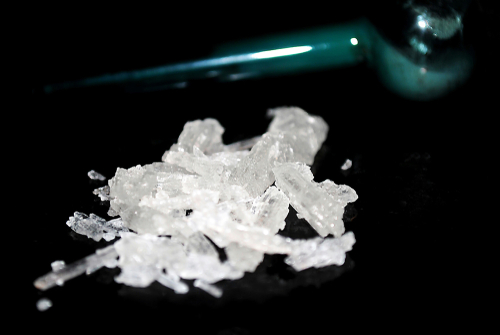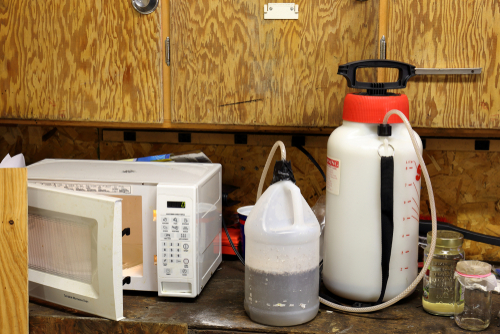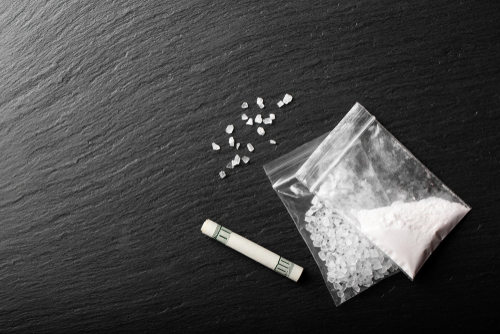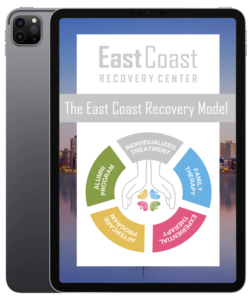If you want to know what is in crank, this article is for you. This short but informative blog is perfect for individuals who are familiar with methamphetamine and those who have zero experience with it. You’ll learn what crank is, what’s usually added to crank, the difference between crank and meth, the short and long-term effects of crank use, common withdrawal symptoms, and the most effective meth addiction plan.

What Is Crank?
“Crank” is a street name for methamphetamine, a chemically synthesized stimulant. In 2022, the Substance Abuse and Mental Health Services Administration reported an estimated 2.6 million people in the US had tried crank, and 1.8 million people met the requirements for methamphetamine use disorder. Meth’s potent but short-lasting effects cause users to get high in long sessions or “binges” to avoid the extreme and uncomfortable comedown that occurs when its effects fade.
Pure crank is usually sold as a white or colorless crystalline powder, while “cut” meth is usually off-white or dyed with shades of green, yellow, pink, and blue. These colors could be added to disguise crank as another stimulant or psychoactive, such as ecstasy or PCP, sold or passed out in clubs or at music festivals.
Crank is also referred to as the “poor man’s cocaine” since an 8-ball (3.5 grams) of cocaine costs around $100 to $160 while an 8-ball of crank costs around $40 to $60. It’s also reported that the effects of crank can last up to 12 hours, while the effects of cocaine only last 15 to 30 minutes. Combining its lower price and longer effects makes crank one of the most desired and dangerous stimulants in the US.
Note: Despite the high cost and availability of crank, cocaine use remains a widespread problem in the US, with over 5 million active users and 1.4 million people meeting the criteria for a cocaine use disorder in 2022.
Connect With Us Now
Reach out to us now for immediate support, or let us know the best time to contact you through our confidential callback service. Your journey to healing is just a conversation away.
Crank Vs. Meth
Crank and meth refer to the same thing. However, there’s a rare chance someone mentioning or talking about meth is referring to Desoxyn, the only FDA-approved medication in the US containing methamphetamine. This rare medication was dispensed 8,000 times in 2021 and is nowhere near as strong or unregulated as crank sold on the street. Desoxyn contains only 5 mg of pharmaceutical-grade methamphetamine, in stark contrast to an 8-ball of crank, which can have up to 3,500 mg of semi-pure methamphetamine. Despite the context, if you hear a loved one or friend discussing using crank, now’s the time to speak up and offer positive advice.
Read more: Is Adderall Like Meth? Differences & Similarities

What’s Added To Crank?
Crank is made in illegal labs by unqualified chemists called “cooks” who add adulterants to spread out their batches, sell more meth, and intensify or alter its effects. Some of these adulterants are near impossible to spot with the naked eye, and meth users could unknowingly consume a poisonous toxin. Some of these additives include:
- Lithium metal: This highly reactive alkali metal is mainly used in batteries, particularly lithium-ion batteries found in toys, power tools, and electric vehicles.
- Hydrochloric acid: This strong acid is commonly used in laboratories for chemical analysis and various industrial processes, including metal cleaning and food processing.
- Iodine: This halogen element is often used in medicine as an antiseptic and in the production of certain pharmaceuticals.
- Sulfuric acid: This strong mineral acid is used to manufacture fertilizers, detergents, dyes, glues, and wood preservatives.
- Red phosphorus: This form of phosphorus is used to produce safety matches, pyrotechnics, incendiary shells, smoke bombs, pesticides, and semiconductors.
Inhaling, snorting, or injecting substances like lithium metal, hydrochloric acid, iodine, sulfuric acid, or red phosphorus can lead to severe and diverse health risks, including vomiting, tissue damage, abdominal pain, damage to the respiratory and digestive systems, and death.
Note: In 2005, the Drug Enforcement Agency (DEA) reported seizing less than one pound of crank at a time during meth lab raids, varying around 60% purity. In 2019, they reported seizing between 120 and 250 pounds of meth during a single raid, with an average purity of 90%. Higher purity methamphetamine is also called “crystal meth” because of its glass-like resemblance.
Take Our Addiction Quiz For Recovery Insights
Short-term Effects Of Crank
Even in small doses, some of the short-term effects of crank include:
- Heightened sense of mental and physical energy: This can lead to excessive talking and movement.
- Euphoria: Despite its momentary bliss, euphoria can lead to risky behavior, impaired judgment, mental health issues, and addiction.
- Increase alertness and wakefulness: This can cause anxiety, panic attacks, and insomnia.
- Increased heart rate: This can lead to chills, chest discomfort, and shortness of breath.
- Lowered appetite: Crank’s appetite suppressant effects can lead to malnourishment, fatigue, weight loss, and muscle loss.
- Increase body temperature: This can lead to exhaustion, dehydration, sweating, dizziness, and nausea.
Long-term Effects Of Crank
Long-term effects of crank use include:
- Irritability: This can lead to paranoia, aggression, violence, and rash decisions. One study by the Australian Institute of Criminology found that men and women who consumed stimulants at high levels were more likely to commit domestic violence on the same day.
- Tremors and convulsions: This can lead to impaired motor skills, involuntary spasms, jerking movements, and brain damage or death from oxygen deprivation.
- Worsened mental health issues: Crank’s stimulating effects can be appealing to individuals predisposed or struggling with ADHD, depression, anxiety, and psychosis. Some chronic meth users displayed symptoms similar to those caused by post-traumatic stress disorder, such as flashbacks, hypervigilance, avoidance, and impaired memory and cognitive function.
- Increased risk of chronic diseases: Crank use can lead to heart disease, stroke, lung cancer, damage to the liver, kidney, and immune system, and chronic inflammation. Additionally, meth users can experience a decline in oral hygiene, leading to tooth decay, gum disease, teeth grinding (bruxism), and bath breath (halitosis).
- Premature aging: Chronic meth users typically have pale, wrinkled, dry, scabbed, and unhealthy skin due to poor diets, lack of sleep and exercise, and compromised immune systems. This makes them appear older and more susceptible to infections and illnesses.
- Death: Health conditions that develop from meth use, including anorexia, hyperthermia, seizures, stroke, and heart attacks, can all result in death.
Crank Withdrawal Symptoms
Chronic meth abuse can cause the body to physically and psychologically become dependent on methamphetamine. When someone abruptly stops using meth, their body can experience mild to severe withdrawal symptoms as it panics to its absence. The most common crank withdrawal symptoms include:
- Partial or complete lack of sleep
- Increased appetite (to compensate for the lack of nutrients and healthy food).
- Restlessness
- Anxiety and panic attacks
- Depression
- Psychosis (this might include visual, auditory, and tactile hallucinations and delusions).
- Cravings

Crank Addiction Treatment Options
The most effective way to treat methamphetamine use disorder involves transitioning between intense and less intense levels of care. This allows individuals to process each step of recovery one at a time until they eventually graduate from a treatment plan and take on sobriety themselves. A typical methamphetamine addiction treatment plan includes:
- Medical detox: One of the most common withdrawal symptoms of meth is cravings. These intense feelings and urges to smoke, snort, or inject meth can easily throw a wrench in someone’s goal toward sobriety. A meth user might start a new day wanting to quit, but as soon as the first set of cravings kicks in, they might run to their meth stash or call a local dealer. Medically-assisted detox is the best way to ensure someone has no access to meth and can resist cravings and avoid uncomfortable withdrawal symptoms until it leaves their system. Detox usually lasts between 3 and 5 days and up to a week in severe cases.
- Residential or Day Treatment program (PHP): Residential programs, also known as inpatient treatment, have clients stay overnight with round-the-clock medical supervision. Partial Hospitalization Programs (PHP) need clients to be there most of the day, like a full-time job, and they can go home in the evening. Some PHPs provide on-site sober living options where clients live close to treatment in a safe environment, even though there isn’t continuous medical supervision.
- Outpatient treatment: Once someone’s transitioned out of a residential or PHP program, which usually lasts 14 to 30 days, they’ll likely move into an outpatient program. This allows individuals to attend meth addiction treatment during the day and return home in the afternoon. Because clients are allowed to go home, outpatient treatment is geared toward individuals who are confident in their recovery goals and ability to resist meth use. Outpatient treatment usually lasts between 30 and 90 days.
- Aftercare: Once someone graduates from an outpatient program, an addiction treatment center can design an individualized aftercare plan. This might involve weekly in-person or online therapy sessions, monthly group meetings, and alums events and activities. The goal of aftercare is to keep clients connected to their recovery journey.
Are You Covered For Treatment?
East Coast Recovery Center partners with numerous private insurance providers. Our team is committed to assisting you in quickly and effortlessly verifying your insurance coverage for treatment.
Contact East Coast Recovery In Boston, MA
If you or someone you know is using crank, contact East Coast Recovery in Boston, Massachusetts. Our meth addiction treatment program is the perfect place to overcome life-altering substance use disorders and contributing mental health conditions. Founded by recovery community members, East Coast Recovery is dedicated to helping everyone who needs it, including working with most major health insurance and crafting affordable payment plans. Call today, and one of our admissions agents can help you get started.










